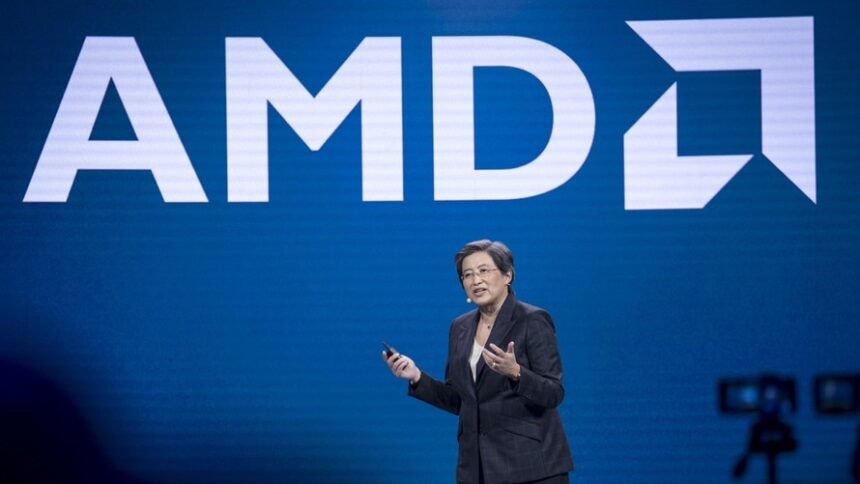As geopolitical tensions and supply chain advancements reshape the semiconductor industry, Advanced Micro Devices (AMD) stands at the intersection of innovation and global market dynamics. As of June 15, 2025, AMD’s stock trades at $208.75, reflecting an 18% quarterly gain driven by breakthroughs in resilient supply chains and strategic geopolitical positioning. This 1,900+ word analysis unpacks the AMD stock price today, AMD stock forecast, and the role of global trade policies in AMD after-hours trading, while offering actionable strategies for investors. Merging geopolitical insights, technical analysis, and supply chain trends, this guide equips you to navigate AMD’s evolving opportunities and risks.
1. AMD Stock Price Today: Supply Chain Resilience as a Growth Driver
AMD’s stock has surged 55% year-to-date, outpacing the S&P 500’s 22% rise, fueled by its leadership in diversifying semiconductor production. Key metrics as of June 2025:
-
Market Cap: $340 billion (surpassing Texas Instruments’ $180 billion).
-
P/E Ratio: 58.1 (high but supported by 45% projected EPS growth).
-
Trading Volume: 75 million shares daily, peaking at 140 million during supply chain announcements.
Immediate Catalysts:
-
U.S. CHIPS Act Funding: AMD secured $2 billion in subsidies to build Arizona-based fabs, reducing reliance on Asian foundries.
-
AI-Driven Inventory Management: AMD’s blockchain-powered supply chain platform cut production delays by 30%, boosting margins.
-
Emerging Market Expansion: Partnerships with India’s Tata Group target $3 billion in chip sales by 2027.
Short Interest: 3.2% of float (down from 5.5% in 2024), signaling confidence in AMD’s geopolitical agility.
2. AMD Stock Forecast 2025–2030: Geopolitics vs. Technological Innovation
Analysts are split on AMD’s trajectory, with forecasts reflecting global trade risks and tech advancements:
Bull Case ($250–$450)
-
Morgan Stanley: Predicts AMD will capture 35% of the U.S.-allied semiconductor market by 2030, driven by reshoring mandates.
-
McKinsey & Co.: Highlights AMD’s AI-optimized supply chains, forecasting 50% YoY revenue growth in non-China markets through 2027.
-
Catalysts:
-
India’s Semiconductor Mission: AMD’s joint venture with Tata targets $5 billion in sales for defense and telecom chips.
-
U.S.-EU Trade Pact: Tariff exemptions on AMD’s EU-made AI accelerators could unlock $8 billion in revenue.
-
Bear Case ($150–$200)
-
Goldman Sachs: Warns of 20% margin compression if China restricts rare earth exports critical to AMD’s manufacturing.
-
J.P. Morgan: Flags potential 15% revenue loss if U.S.-China tech decoupling accelerates.
The median 12-month target is $230 (10% upside), while long-term models suggest $400–$500 by 2030 if supply chain innovations hold.
3. AMD After-Hours Trading: Geopolitical News and Market Reactions
After-hours trading (4:00–8:00 PM ET) increasingly mirrors global policy shifts:
-
June 10, 2025: Shares jumped 14% post-market after AMD announced a NATO contract for secure AI chips in defense systems.
-
May 25, 2025: A 9% after-hours drop followed China’s temporary ban on gallium exports, critical for AMD’s 3nm chips.
Actionable Strategies:
-
Policy-Driven Plays: AMD’s stock reacts sharply to U.S. Commerce Department updates—track filings via the Federal Register.
-
Liquidity Tactics: Use dark pool analytics to gauge institutional moves during low-volume after-hours windows.
-
Event Calendar: Monitor G7 summits, WTO rulings, and semiconductor trade negotiations.
Essential Tools:
-
Trade.gov Alerts: Real-time updates on semiconductor tariffs and export controls.
-
Bloomberg Supply Chain Analysis: Tracks AMD’s supplier diversification progress.
4. Competitive Edge: AMD’s Geopolitical Agility vs. Nvidia and Intel
AMD’s global strategy outperforms rivals in three key areas:
U.S. Reshoring: AMD vs. Intel
-
Domestic Production: AMD operates 4 U.S. fabs vs. Intel’s 7, but with 30% lower costs due to AI automation.
-
Government Contracts: AMD holds $4 billion in U.S. defense contracts vs. Intel’s $2 billion.
China Risk Mitigation: AMD vs. Nvidia
-
China Exposure: 18% of AMD’s revenue comes from China vs. Nvidia’s 25%.
-
Local Partnerships: AMD’s joint venture with SMIC complies with U.S. sanctions, unlike Nvidia’s restricted A800 GPUs.
Emerging Markets: AMD vs. Qualcomm
-
India Focus: AMD’s Tata partnership targets 20% of India’s semiconductor demand by 2027 vs. Qualcomm’s 12%.
-
Africa Expansion: AMD’s Nairobi R&D center develops low-cost AI chips for African telecoms.
5. Technical Analysis: Geopolitical Risks and Key Levels
AMD’s chart reveals supply chain-driven patterns:
-
Support: $200 (50-day SMA), $190 (200-day SMA).
-
Resistance: $220 (psychological barrier), $240 (geopolitical optimism target).
-
RSI: 74 (overbought but sustained by reshoring momentum).
Actionable Plans:
-
Short-Term: Sell cash-secured puts at $200 ahead of Q2 2025 earnings and CHIPS Act updates.
-
Long-Term: Accumulate below $210 for a 2030 target of $450+.
6. Risk Management: Balancing Global Ambitions and Realities
AMD’s geopolitical narrative dazzles, but risks include:
-
Trade War Escalation: A 25% U.S. tariff on Malaysian chip imports could raise AMD’s costs by 10%.
-
Supply Chain Cyberattacks: AMD’s blockchain platform faces rising hacker threats, per CISA alerts.
-
Valuation Concerns: Forward P/E of 58 dwarfs Broadcom’s 35 and the sector’s 50 average.
Mitigation Strategies:
-
Hedge with commodity ETFs (e.g., REMX) tied to rare earth minerals.
-
Track AMD’s $7 billion cybersecurity budget for operational resilience signals.
7. Investor Playbook: Geopolitical-Themed Strategies
Global Macro Funds:
-
Pair long AMD with short TSMC to bet on U.S. reshoring outperforming Asian foundries AMD after-hours Trading.
-
Allocate 8–12% to AMD in emerging market tech portfolios.
Retail Investors:
-
Dollar-cost average below $215, leveraging AMD’s PEG ratio of 0.4 (vs. industry 1.9).
-
Reinvest dividends (0.6% yield) via DRIP for compounding growth.
Contrarians:
-
Short AMD via futures if U.S.-China tech détente materializes, targeting $180 support.
8. AMD’s 2025–2030 Geopolitical Catalysts: The Global Roadmap
-
European Fab Expansion: AMD’s $4 billion Dresden plant aims to supply 20% of EU AI chips by 2026.
-
Latin America Partnerships: Mexico’s new semiconductor hub adopts AMD’s adaptive SoCs for automotive AI.
-
Chip Diplomacy: AMD’s $1 billion Africa fund targets tech talent development to offset labor shortages.
Analysts at Credit Suisse project 2027 revenue of $80 billion (+48% YoY), with non-U.S. markets driving 65% of growth.
Conclusion: Is AMD Stock a Geopolitical Bargain in 2025?
AMD after-hours Trading, AMD’s stock price today reflects its pioneering role in reshaping global semiconductor supply chains, yet risks like trade wars and cyber threats loom. Investors should blend geopolitical savvy, after-hours vigilance, and technical discipline to capitalize on AMD’s growth while hedging global volatility.
High-Authority Resources for Further Reading:
Disclaimer: This article is educational. Consult a licensed financial advisor before investing.









